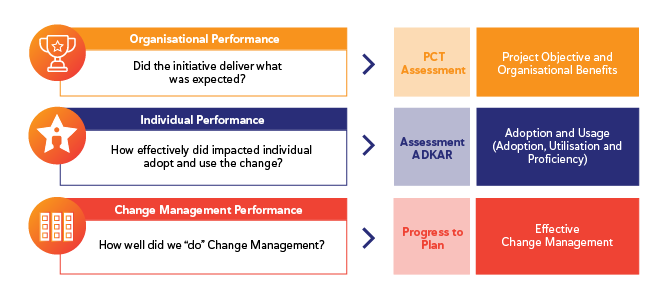"You will fail without a change sustainment plan": the most advanced tools to succeed.
13 June 2022
Why sustainment is so essential and the steps to make change last.
Article written by Morten Kamp Andersen
13 June 2022
Why sustainment is so essential and the steps to make change last.
Article written by Morten Kamp Andersen
Embarking on a change journey is the closest thing to running a marathon. It requires drive, training, ability, consistent efforts, and the will to push through fatigue. But unlike marathons, the finish line isn't clearly signposted. And more importantly, it should not be mistaken for technical implementation completion.
Consider the standard start-to-finish sequence in project management. After careful planning, the change project typically enters one or multiple "3-D cycle(s)" whereby dedicated teams Design, Develop, and Deploy the solution. All done? Not really. You will have to go the extra mile to sustain outcomes. There is no getting around this golden rule. Without solid reinforcement strategies, only 17% of change projects deliver on their promises With successful sustainment, however, figures jump to a whopping 70%.
The bottom line is that people are creatures of habits. Releasing pressure too quickly always places the whole initiative on a slippery slope. That's why sustainment might well be the most delicate and critical part of any change endeavour. But it doesn't have to be messy or drag on for a very long time if you know what is to be done. Here is where the Prosci 3-phase change process (3/3) comes in handy. Act on your performance reviews, activate the right roles, transfer ownership, and create change that sticks!
Our previous post touched upon the significance of performance assessments for course-correction purposes and opportunities discovery. An important part of Phase 2 - "Managing the change", performance evaluation is also the first building block of Phase 3.
It is essential to keep an eye on performance after the change has been made. That means tracking metrics and KPIs, conducting surveys, and collating feedback. By examining results, you can ensure that the change project meets or even exceeds expectations – which is also the best way to make a case for Change Management. Likewise, you can identify areas that still need improvement.
Evaluation is a multi-layered process that targets 3 different organisational, individual, and CM-related levels. You will be using different tools to build data from various sources and answer the following questions:

Too many organisations jump straight to the next change, doing minimal reinforcement if any at all. Some of the most common reasons include running low on dedicated resources and the CM team's “inability to keep internal momentum”. Cutting on Change Management resources – especially when reaching Phase 3 – is a surefire way to jeopardise the whole change initiative.
The "What". After evaluating performance at all three levels, look for gaps and set goals/ priorities. This will be used to establish sustainment activities, roles, and milestones. Besides measuring against success, the four most common sustainment activities reported in a recent PROSCI survey include:
1. Continuing communication
2. Continuing to train
3. Creating support materials
4. Celebrating, rewarding and recognising success
The "Who". To create and execute the sustainment plan, you must activate a few key roles just as you did during Phase 2.
The Change Manager or CM team should spearhead the effort, secure sponsorship, and foster early coordination between CM and PM (Project Management). Project sponsors and owners are then supposed to step in and take control swiftly. The same goes for managers who are most familiar with front-line workers and typically fill the 5 CLARC positions (Communicator, Liaison, Advocate, Resistance Manager, Coach). Executive leaders, needless to say, must take the floor frequently and continue to model behaviours.
But "how long"? The overall length of the project determines the duration of sustainment activities. Around half of those polled by PROSCI's survey said that a project averaging 24 months takes more than a year to sustain. Those with durations ranging from 12 to 24 months require at least 6 months to 1 year. Therefore, to establish a realistic deadline for the entire project, you must factor in the time to consolidate the change.
A word of caution: make sure you reach the required threshold to transfer ownership and empower internal resources.
You can usually tell when something has become "business as usual". Alongside organisational performance results and overall employee satisfaction, anything that demonstrates that employees are proficient with the solution should indicate that the change is solidifying. It might involve low error rates, no or few questions asked, new or extremely specific inquiries, and a sense that previous working processes were rather time-consuming … and burdensome.
When you are done on the field, transfer knowledge and transition responsibilities from the CM team to the project owner(s) and those impacted in the long run. Change is made by the people, for the people. If they own the change, they will make it last.
Do you want to apply PROSCI's updated methodology to one of your projects for quick wins and long-term results? Save this series and check out our upcoming training sessions!